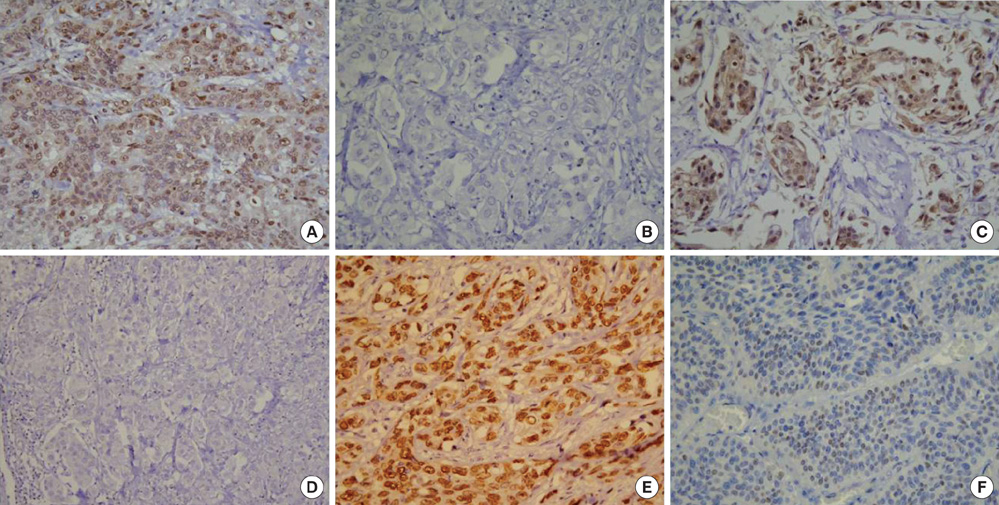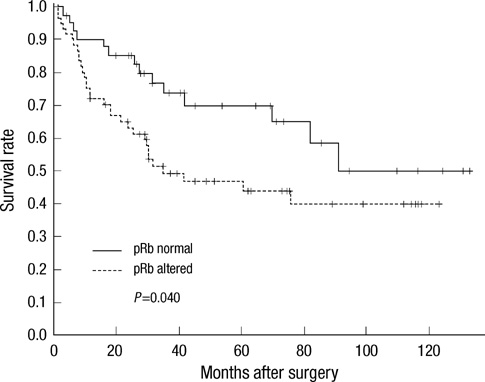J Korean Med Sci.
2010 Oct;25(10):1449-1455. 10.3346/jkms.2010.25.10.1449.
Expression of pRb, p53, p16 and Cyclin D1 and Their Clinical Implications in Urothelial Carcinoma
- Affiliations
-
- 1Department of Hospital Pathology, College of Medicine, The Catholic University of Korea, Seoul, Korea. klee@catholic.ac.kr
- KMID: 2157848
- DOI: http://doi.org/10.3346/jkms.2010.25.10.1449
Abstract
- The aim of this study was to assess immunohistochemical expression of p53, pRb, p16, and cyclin D1, alone or in combination, as prognostic indicators and to investigate their correlation with clinocopathologic features of urothelial carcinoma. Immunohistochemical staining for p53, pRb, p16, and cyclin D1 was performed on a tissue microarray from 103 patients with urothelial carcinoma who underwent radical cystectomy. Of the patient samples analyzed, 36 (35%), 61 (59%), 47 (46%) and 30 (29%) had altered expression of p53, pRb, p16, and cyclin D1, respectively. Abnormal expression of p53 and pRb correlated with depth of invasion (P=0.040 and P=0.044, respectively). Cyclin D1 expression was associated with tumor stage and recurrence (P=0.017 and P=0.036, respectively). Altered pRb was significantly correlated with overall survival (P=0.040). According to the expression pattern of pRb and p53, p53/pRb (altered/normal) had worse survival than p53/pRb (normal/altered) (P=0.022). Alteration of all markers had worse survival than all normal (P=0.029). As determined by multivariate analysis, tumor stage, lymph node metastasis and the combined expression of p53 and pRb are independent prognostic factors. In conclusion, immunohistochemical evaluation of cell cycle regulators, especially the p53/pRb combination, might be useful in planning appropriate treatment strategies.
Keyword
MeSH Terms
-
Adult
Aged
Aged, 80 and over
Carcinoma, Transitional Cell/*metabolism/mortality/pathology
Cyclin D1/*metabolism
Cyclin-Dependent Kinase Inhibitor p16/*metabolism
Female
Humans
Immunohistochemistry
Lymphatic Metastasis
Male
Middle Aged
Multivariate Analysis
Neoplasm Staging
Prognosis
Recurrence
Retinoblastoma Protein/*metabolism
Survival Rate
Tumor Suppressor Protein p53/*metabolism
Urinary Bladder Neoplasms/*metabolism/mortality/pathology
Figure
Reference
-
1. Parkin DM, Bray F, Ferlay J, Pisani P. Global cancer statistics, 2002. CA Cancer J Clin. 2005. 55:74–108.
Article2. Jung KW, Won YJ, Park S, Kong H, Sung J, Shin H, Park E, Lee JS. Cancer statistics in Korea: incidence, mortality and survival in 2005. J Korean Med Sci. 2009. 24:995–1003.
Article3. Shin HR, Jung KW, Won YJ, Park JG. 2002 Annual Report of the Korea Central Cancer Registry: Based on Registered Data from 139 Hospitals. Cancer Res Treat. 2004. 36:103–114.
Article4. Eble JN, Sauter G, Epstein JI, Sesterhenn IA. The world health organization classification of tumors of the urinary system and male genital system. 2004. Lyon: IARC press;92–109.5. Margulis V, Lotan Y, Montorsi F, Shariat SF. Predicting survival after radical cystectomy for bladder cancer. BJU Int. 2008. 102:15–22.
Article6. Williams SG, Stein JP. Molecular pathways in bladder cancer. Urol Res. 2004. 32:373–385.
Article7. Im S, Yoo C, Jung JH, Choi HJ, Yoo J, Kang SJ, Lee KY. Alteration of G1/S cell cycle regulatory proteins in carcinogenesis of cutaneous squamous cell carcinomas. Korean J Pathol. 2009. 43:542–549.
Article8. Cote RJ, Dunn MD, Chatterjee SJ, Stein JP, Shi SR, Tran QC, Hu SX, Xu HJ, Groshen S, Taylor CR, Skinner DG, Benedict WF. Elevated and absent pRb expression is associated with bladder cancer progression and has cooperative effects with p53. Cancer Res. 1998. 58:1090–1094.9. Shariat SF, Ashfaq R, Sagalowsky AI, Lotan Y. Association of cyclin D1 and E1 expression with disease progression and biomarkers in patients with nonmuscle-invasive urothelial cell carcinoma of the bladder. Urol Oncol. 2007. 25:468–475.
Article10. Shariat SF, Tokunaga H, Zhou J, Kim J, Ayala GE, Benedict WF, Lerner SP. p53, p21, pRB, and p16 expression predict clinical outcome in cystectomy with bladder cancer. J Clin Oncol. 2004. 22:1014–1024.
Article11. Shariat SF, Zlotta AR, Ashfaq R, Sagalowsky AI, Lotan Y. Cooperative effect of cell-cycle regulators expression on bladder cancer development and biologic aggressiveness. Mod Pathol. 2007. 20:445–459.
Article12. Shariat SF, Chade DC, Karakiewicz PI, Ashfaq R, Isbarn H, Fradet Y, Bastian PJ, Nielsen ME, Capitanio U, Jeldres C, Montorsi F, Lerner SP, Sagalowsky AI, Cote RJ, Lotan Y. Combination of multiple molecular markers can improve prognostication in patients with locally advanced and lymph node positive bladder cancer. J Urol. 2010. 183:68–75.
Article13. Chatterjee SJ, Datar R, Youssefzadeh D, George B, Goebell PJ, Stein JP, Young L, Shi SR, Gee C, Groshen S, Skinner DG, Cote RJ. Combined effects of p53, p21, and pRb expression in the progression of bladder transitional cell carcinoma. J Clin Oncol. 2004. 22:1007–1013.
Article14. Loden M, Stighall M, Nielsen NH, Roos G, Emdin SO, Ostlund H, Landberg G. The cyclin D1 high and cyclin E high subgroups of breast cancer: separate pathways in tumorogenesis based on pattern of genetic aberrations and inactivation of the pRb node. Oncogene. 2002. 21:4680–4690.
Article15. Knowles MA. What we could do now: molecular pathology of bladder cancer. Mol Pathol. 2001. 54:215–221.
Article16. Hitchings AW, Kumar M, Jordan S, Nargund V, Martin J, Berney DM. Prediction of progression in pTa and pT1 bladder carcinomas with p53, p16 and pRb. Br J Cancer. 2004. 91:552–557.
Article17. Cho SY, Kim YS, Hong SJ. Prognostic significance of p53, pRb, and p21 (waf1) in T1G3 bladder cancer. Korean J Urol. 2002. 43:678–682.18. Richter J, Beffa L, Wagner U, Schraml P, Gasser TC, Moch H, Mihatsch MJ, Sauter G. Patterns of chromosomal imbalances in advanced urinary bladder cancer detected by comparative genomic hybridization. Am J Pathol. 1998. 153:1615–1621.
Article19. Simon R, Burger H, Semjonow A, Hertle L, Terpe HJ, Bocker W. Patterns of chromosomal imbalances in muscle invasive bladder cancer. Int J Oncol. 2000. 17:1025–1029.
Article20. Xu HJ, Cairns P, Hu SX, Knowles MA, Benedict WF. Loss of RB protein expression in primary bladder cancer correlates with loss of heterozygosity at the RB locus and tumor progression. Int J Cancer. 1993. 53:781–784.
Article21. Benedict WF, Lerner SP, Zhou J, Shen X, Tokunaga H, Czerniak B. Level of retinoblastoma protein expression correlates with p16 (MTS-1/INK4A/CDKN2) status in bladder cancer. Oncogene. 1999. 18:1197–1203.
Article22. Ebstein JI. Kumar V, Abbas AK, Fausto N, Aster JC, editors. The lower urinary tract and male genital system. Pathologic Basis of Disease. 2010. 8th ed. Philadelphia: Elsevier;976–980.23. Amin MB, Gómez JA, Young RH. Urothelial transitional cell carcinoma with endophytic growth patterns: a discussion of patterns of invasion and problems associated with assessment of invasion in 18 cases. Am J Surg Pathol. 1997. 21:1057–1068.
- Full Text Links
- Actions
-
Cited
- CITED
-
- Close
- Share
- Similar articles
-
- Expression of pRb, p16, Cyclin D1 and Cyclin E in Infiltrating Duct Carcinoma of the Breast
- Significance of Expression of p16, Cyclin D1, Rb, and p53 Protein and Correlation with Clinicopathologic Prognostic Factors in Invasive Ductal Carcinoma of the Breast
- Expression of p16 Protein and Cyclin D1 Protein in Head and Neck Squamous Cell Carcinomas
- Expression of G1/S Phase Checkpoint Proteins in Breast Carcinoma: Relationship to Clinicopathologic Factors andSurvival Rate
- p16(INK4A) promoter hypermethylation and expression of p16(INK4A), cyclin D1, and Rb in papillary thyroid carcinoma





